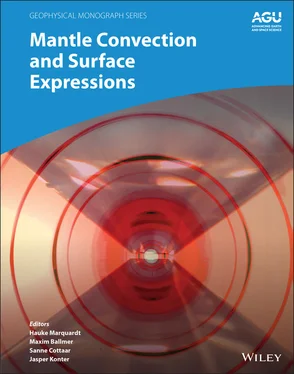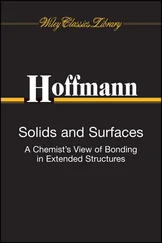204 Wenk, H.‐R., Lonardelli, I., Merkel, S., Miyagi, L., Pehl, J., Speziale, S., & Tommaseo, C. E. (2006). Deformation textures produced in diamond anvil experiments, analysed in radial diffraction geometry. Journal of Physics Condensed Matter, 18(25). https://doi.org/10.1088/0953‐8984/18/25/S02
205 Wenk, H.‐R., Speziale, S., McNamara, A. K., & Garnero, E. J. (2006). Modeling lower mantle anisotropy development in a subducting slab. Earth and Planetary Science Letters, 245(1–2), 302–314. https://doi.org/10.1016/j.epsl.2006.02.028
206 Wenk, H.‐R., Cottaar, S., Tomé, C. N., McNamara, A., & Romanowicz, B. (2011). Deformation in the lowermost mantle: From polycrystal plasticity to seismic anisotropy. Earth and Planetary Science Letters, 306(1–2), 33–45. https://doi.org/10.1016/J.EPSL.2011.03.021
207 Wenk, H.‐R., Lutterotti, L., Kaercher, P., Kanitpanyacharoen, W., Miyagi, L., & Vasin, R. (2014). Rietveld texture analysis from synchrotron diffraction images. II. Complex multiphase materials and diamond anvil cell experiments. Powder Diffraction, 29(3). https://doi.org/10.1017/S0885715614000360
208 Wookey, J., Kendall, J.‐M., & Barruol, G. (2002). Mid‐mantle deformation inferred from seismic anisotropy. Nature, 415(6873), 777–780. https://doi.org/10.1038/415777a
209 Wu, X., Lin, J. F., Kaercher, P., Mao, Z., Liu, J., Wenk, H. R., & Prakapenka, V. B. (2017). Seismic anisotropy of the D″ layer induced by (001) deformation of post‐perovskite. Nature Communications, 8, 1–6. https://doi.org/10.1038/ncomms14669
210 Xu, J., Yamazaki, D., Katsura, T., Wu, X., Remmert, P., Yurimoto, H., & Chakraborty, S. (2011). Silicon and magnesium diffusion in a single crystal of MgSiO 3 perovskite. Journal of Geophysical Research, 116(B12), B12205. https://doi.org/10.1029/2011JB008444
211 Xu, S. C., Wang, L. D., Zhao, P. T., Li, W. L., Xue, Z. W., & Fei, W. D. (2011). Evolution of texture during hot rolling of aluminum borate whisker‐reinforced 6061 aluminum alloy composite. Materials Science and Engineering: A, 528(7–8), 3243–3248. https://doi.org/10.1016/J.MSEA.2010.12.103
212 Xu, Y., Nishihara, Y., & Karato, S. (2005). Development of a rotational Drickamer apparatus for large‐strain deformation experiments at deep Earth conditions. Advances in High‐Pressure Technology for Geophysical Applications, 167–182. https://doi.org/10.1016/B978‐044451979‐5.50010‐7
213 Yamazaki, D., & Karato, S. I. (2001a). High‐pressure rotational deformation apparatus to 15 GPa. Review of Scientific Instruments, 72(11), 4207–4211. https://doi.org/10.1063/1.1412858
214 Yamazaki, D., & Karato, S. I. (2001b). Some mineral physics constraints on the rheology and geothermal structure of Earth’s lower mantle. American Mineralogist, 86(4), 385–391. https://doi.org/10.2138/am‐2001‐0401
215 Yamazaki, D., & Karato, S. I. (2002). Fabric development in (Mg,Fe)O during large strain, shear deformation: Implications for seismic anisotropy in Earth’s lower mantle. Physics of the Earth and Planetary Interiors, 131(3–4), 251–267. https://doi.org/10.1016/S0031‐9201(02)00037‐7
216 Yamazaki, D., Kato, T., Yurimoto, H., Ohtani, E., & Toriumi, M. (2000). Silicon self‐diffusion in MgSiO3 perovskite at 25 GPa. Physics of the Earth and Planetary Interiors, 119(3–4), 299–309. https://doi.org/10.1016/S0031‐9201(00)00135‐7
217 Yamazaki, D., Yoshino, T., Ohfuji, H., Ando, J. ichi, & Yoneda, A. (2006). Origin of seismic anisotropy in the D″ layer inferred from shear deformation experiments on post‐perovskite phase. Earth and Planetary Science Letters, 252(3–4), 372–378. https://doi.org/10.1016/j.epsl.2006.10.004
218 Yoshizawa, Y., Toriyama, M., & Kanzaki, S. (2004). Fabrication of Textured Alumina by High‐Temperature Deformation. Journal of the American Ceramic Society, 84(6), 1392–1394. https://doi.org/10.1111/j.1151‐2916.2001.tb00848.x
219 Zhang, W. L., Gu, M. Y., Wang, D. Z., & Yao, Z. K. (2004). Rolling and annealing textures of a SiCw/Al composite. Materials Letters, 58(27–28), 3414–3418. https://doi.org/10.1016/J.MATLET.2004.05.065
3 Seismic Wave Velocities in Earth’s Mantle from Mineral Elasticity
Johannes Buchen
Seismological Laboratory, California Institute of Technology, Pasadena, CA, USA
The propagation of seismic waves through Earth’s mantle is controlled by the elastic properties of the minerals that form mantle rocks. Changes in pressure, temperature, and chemical composition of the mantle as well as phase transitions affect seismic wave speeds through their impact on mineral elasticity. The elastic properties of minerals can be determined in experiments and by first-principle computations and be combined to model the elastic wave speeds of mantle rocks. Based on recent advances, I evaluate the uncertainties on modeled elastic wave speeds and explore their sensitivity to physical and chemical key parameters. I discuss the elastic properties of solid solutions and elastic anomalies that arise from continuous phase transitions, such as spin transitions and ferroelastic phase transitions. Models for rocks of Earth’s lower mantle indicate that continuous phase transitions and Fe‐Mg exchange between major mantle minerals can have significant impacts on elastic wave speeds. When viewed in context with other constraints on the structure and dynamics of the lower mantle, mineral-physical models for the elastic wave speeds of mantle rocks can help to separate thermal from compositional signals in the seismic record and to identify patterns of material transport through Earth's deep interior.
Seismic waves irradiated from intense earthquakes propagate through Earth’s interior and probe the physical properties of materials that constitute Earth’s mantle. Analyzing travel times and wave forms of seismic signals allows reconstructing the propagation velocities of seismic waves in Earth’s interior. With the fast‐growing body of seismic data and improvements in seismological methods, such reconstructions reveal more and more details about Earth’s deep seismic structure. The propagation velocities of body waves, i.e., compressional ( P ) and shear ( S ) waves, are mainly controlled by the elastic properties of the mantle. The interpretation of seismic observations therefore requires a profound understanding of how pressure, temperature, and chemical composition affect the elastic properties of candidate materials. High‐pressure experiments and quantum‐mechanical calculations have been devised to sample thermodynamic and elastic properties of deep-earth materials by simulating the extreme conditions deep within Earth’s mantle. Their results serve as anchor points for thermodynamic models that allow predicting the elastic properties of mantle rocks for comparison with seismic observations.
The task of assessing the composition of Earth’s interior by comparing seismic velocities with elastic properties of candidate materials was pioneered by Francis Birch (Birch, 1964, 1952). Building on the work of Murnaghan (Murnaghan, 1937), Birch was also among the first to advance finite‐strain theory for describing the elastic properties of materials subjected to strong compressions (Birch, 1947, 1939, 1938). Further extensions and generalizations of finite‐strain formulations (Davies, 1974; Thomsen, 1972a) lead to widespread and successful applications of finite‐strain theory in modeling seismic properties of mantle materials (Bass & Anderson, 1984; Cammarano et al., 2003; Cobden et al., 2009; Davies and Dziewonski, 1975; Duffy & Anderson, 1989; Ita & Stixrude, 1992; Jackson, 1998; Stixrude & Lithgow‐Bertelloni, 2005). Today, compilations of finite‐strain and thermodynamic parameters for mantle minerals and dedicated software tools allow computing phase diagrams for typical rock compositions together with elastic properties (Chust et al., 2017; Connolly, 2005; Holland et al., 2013; Stixrude & Lithgow‐Bertelloni, 2011). Mineral‐physical databases have proven particularly useful in modeling the seismic properties of Earth’s mantle to depths of about 900 km (Cammarano et al., 2009; Cobden et al., 2008; Xu et al., 2008). To some extent, this success reflects current capabilities of high‐pressure experiments as most major minerals of the upper mantle and transition zone can be synthesized and their elastic properties be determined for relevant compositions and at realistic pressures and temperatures, limiting the need for far extrapolations.
Читать дальше












